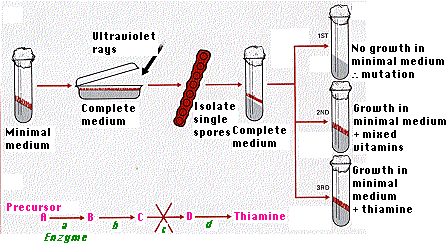6.1: One Gene - One Enzyme Theory
- Page ID
- 4833
Neurospora crassa
Neurospora crassa is an ascomycete, the red bread mold. Like all fungi, it reproduces by spores. It produces two kinds of spores:
- Conidia are spores produced by asexual reproduction. Mitosis of the haploid nuclei of the active, growing fungus generates the conidia.
- Ascospores, on the other hand, are formed following sexual reproduction. If two different mating types ("sexes") are allowed to grow together, they will fuse to form a diploid zygote. Meiosis of this zygote then gives rise to the haploid ascospores.
Neurospora is particularly well suited for genetic studies because
- It can be grown quickly on simple culture medium.
- It spends most of its life cycle in the haploid condition so any recessive mutations will show up in its phenotype.
- When the diploid zygote undergoes meiosis, the nuclei produced by
- Meiosis I, followed by
- Meiosis II, followed by
- one mitotic division
- Because the nuclei cannot slip past one another, if
- the zygote nucleus is heterozygous for a gene (shown here as a and A) and
- no crossing over near that locus occurs during meiosis I,
The One Gene - One Enzyme Theory
Sucrose, a few salts, and one vitamin — biotin — provide the nutrients that Neurospora needs to synthesize all the macromolecules of its cells.

Geneticists George W. Beadle and E. L. Tatum exposed some of the conidia of one mating type of Neurospora to ultraviolet rays in order to induce mutations.
- Then individual irradiated spores were allowed to germinate on a "complete" medium; that is, one enriched with various vitamins and amino acids.
- Once each had developed a mycelium, it was allowed to mate with the other mating type.
- The ascospores produced were dissected out individually and each one placed on complete medium.
- After growth had occurred, portions of each culture were subcultured on minimal medium.
- Sometimes growth continued; sometimes it didn't.
- When it did not ("1st" in the figure) , the particular strain was then supplied with a mixture of vitamins, amino acids, etc. until growth did occur ("2nd ").
- Eventually each mutated strain was found to have acquired a need for one nutrient; in the example illustrated here, the vitamin thiamine ("3rd").
Beadle and Tatum reasoned that radiation had caused a gene that permits the synthesis of thiamine from the simple ingredients in minimal medium to mutate to an allele that does not. The synthesis of thiamine from sucrose requires a number of chemical reactions, each one catalyzed by a specific enzyme.
By adding, one at a time, the different precursors of thiamine to the medium in which their mutant mold was placed, they were able to narrow down the defect to the absence of a single enzyme.
- If they added to the minimal medium any precursor further along in the process, growth occurred.
- Any precursor before the blocked step could not support growth.
Thus, in this example, the conversion of precursor C to precursor D was blocked because of the absence of the needed enzyme (c).
This led them to postulate the one gene - one enzyme theory: each gene in an organism controls the production of a specific enzyme. It is these enzymes that catalyze the reactions that lead to the phenotype of the organism.
Today, we know that, in fact, not only enzymes, but all the other proteins from which the organism is built are encoded by genes.
Contributors and Attributions
John W. Kimball. This content is distributed under a Creative Commons Attribution 3.0 Unported (CC BY 3.0) license and made possible by funding from The Saylor Foundation.


